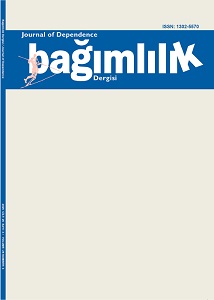MULTİPLE DRUG ABUSE WİTH ZOPİCLONE, DİAZEPAM, GABAPENTİN: CASE REPORT
Keywords:
Multiple Drug Abuse, Diazepam, Gabapentin, ZopicloneAbstract
Multiple drug abuse is a common phenomenon within drug addiction. In many cases, individuals use two, three, or more psychoactive substances, usually from different drug groups, simultaneously.
A 34-year-old non-Turkish woman was diagnosed with anxiety disorder and began paroxetine 20-40 mg/day eight years ago in her home country. At a later date, gabapentin and zopiclone were added to her treatment. The patient, who had abused zopic-lone and gabapentin for four years and was no longer able to obtain them, came to our outpatient clinic. Treatment with diazepam was begun and it was observed that she was also misusing it. Unable to adjust to her new treatment, she failed to return for follow up.
Due to a number of different factors, we believe that this case, in which the patient abused two different benzodiazepines and one antiepileptic, can contribute to the literature.
References
1- Kaufman E. The abuse of multiple drugs. I. Definition, classification, and extent of problem. The American journal of drug and alcohol abuse 1976; 3:279-292.
2- F N. Multiple Drug Abuse and Medicines U-FOLD at Uppsala University Conference; Uppsala, Sweden. 2012.
3- Lugoboni F, Mirijello A, Faccini M, et al. Quality of life in a cohort of high-dose benzodiazepine dependent patients. Drug and alcohol dependence 2014; 142: 105-109.
4- Israel AG, Kramer JA. Safety of zaleplon in the treatment of insomnia. Annals of Pharmacotherapy 2002; 36: 852-859.
5- Yanagita T. Dependence potential of zopiclone studied in monkeys. Pharmacology 1983; 27: 216-227.
6- Clee WB, McBride AJ, Sullivan G. Warning about Zopiclone misuse. Addiction (Abingdon, England) 1996; 91: 1389.
7- Dündar Y, Dodd S, Strobl J, et al. Comparative efficacy of newer hypnotic drugs for the short-term management of insomnia: a systematic review and meta-analysis. Human Psychopharmacology: Clinical and Experimental 2004; 19: 305-322.
8- Palmer CM PHJM, Lopez-Ibor JJ, Andreasen N. Antiepileptic drugs. In: Gelder. New Oxford Textbook of Psychiatry. New York: Oxford University Press, 2000: 1326-1333.
9- Magnus L. Nonepileptic uses of gabapentin. Epilepsia 1999; 40: 66-72.
10- Sethi A, Das BP, Bajaj BK. The anxiolytic activity of gabapentin in mice. Journal of applied research in clinical and experimental therapeutics 2005; 5: 415.
11- Singh L, Field MJ, Ferris P, et al. The antiepileptic agent gabapentin (Neurontin) possesses anxiolytic-like and antinociceptive actions that are reversed byd-serine. Psychopharmacology 1996; 127 :1-9.
12- Cousins MS, Roberts D, Wit Hd. GABA< sub> B receptor agonists for the treatment of drug addiction: a review of recent findings. Drug and alcohol dependence 2002; 65: 209-220.
13- Howland RH. Gabapentin; can it be misused. J Psychosocial Nurs 2014; 52: 12-15.
14- Markowitz JS, Finkenbine R, Myrick H, et al. Gabapentin abuse in a cocaine user: implications for treatment? Journal of clinical psychopharmacology 1997; 17: 423-424.
15- Repchinsky C. Compendium of pharmaceuticals and specialties: the Canadian drug reference for health professionals. Canadian Pharmacists Association 2006.
16-ChilcottLA,ShapiroCM.Thesocioeconomicimpact ofinsomnia. Pharmacoeconomics 1996; 10: 1-14.
17- Busto UE, Sproule BA, Knight K, et al. Use of prescription and nonprescription hypnotics in a Canadian elderly population. The Canadian journal of clinical pharmacology= Journal canadien de pharmacologie clinique 2000; 8: 213-221.
18- Glass J, Lanctôt KL, Herrmann N, et al. Sedative hypnotics in older people with insomnia: meta- analysisofrisksandbenefits.Bmj2005;331:1169.
19- Hajak G. A comparative assessment of the risks and benefits of Zopiclone. Drug Safety 1999; 21: 457-469.
20- Delahaye C, Ferrand B, Pieddeloup C, et al. Post marketing surveillance of zopiclone: interim analysis on the first 10,000 cases in a clinical study in general practice. International clinical psychopharmacology 1990; 5: 131-138.
21- AllainH,DelahayeCH,LeCozF,etal.Postmarketing surveillance of zopiclone in insomnia: analysis of 20,513 cases. Sleep 1991; 14: 408-413.
22-Lader M.Rebound insomniaand newerhypnotics. Psychopharmacology 1992; 108: 248-255.
23- Lader M. Zopiclone: is there any dependence and abuse potential? Journal of neurology 1997; 244: 18-22.
24-Soyka M, BottlenderR, MöllerHJ. Epidemiological evidence for a low abuse potential of zolpidem. Pharmacopsychiatry 2000.
25- Ashton H. Protracted withdrawal from benzodiazepines: The post-withdrawal syndrome. Psychiatric Annals 1995.
Downloads
Published
How to Cite
Issue
Section
License
Copyright (c) 2025 Journal of Dependence

This work is licensed under a Creative Commons Attribution-NonCommercial-NoDerivatives 4.0 International License.
...
